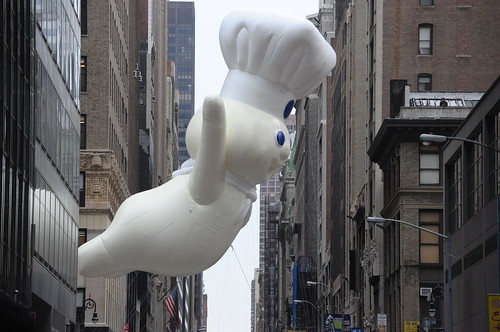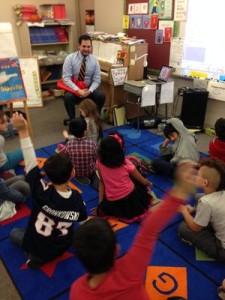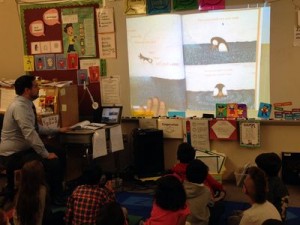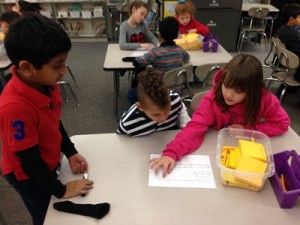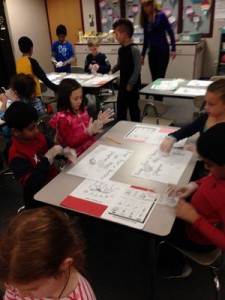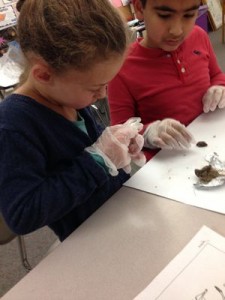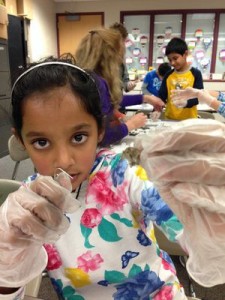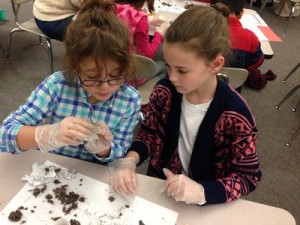Posted by kavery508 | Posted in Uncategorized | Posted on November 29, 2016
I hope you all had a wonderful holiday! I spent some long delayed time catching up with friends and family. And feeling very much like the picture above. I had much to be thankful for, including this great bunch of students and families!
This week marks the end of Trimester 1: we’re 1/3 of the way to grade 3! Students will be taking end-of-term assessments in writing, reading, math, science, and social studies. Report cards are due to come home just before the December break.
 Our reading focus is on learning to use nonfiction text features to make sense of informative texts. Think about a magazine article you’ve recently seen. As accomplished readers, we never just dive in and hope we understand by the end of it; yet, that’s often what kids will do. Instead, we read and think about the title, headings and subheadings, pictures, diagrams, captions, maps, and all the other things that make concepts more comprehensible, all while relating them back to the main idea. This week we will learn many of these features, go hunting for them in text, and use them to improve comprehension. This Reading Mama’s blog puts it well (and is a good source for learning many elements of reading): http://thisreadingmama.com/comprehension/non-fiction/non-fiction-text-structure/
Our reading focus is on learning to use nonfiction text features to make sense of informative texts. Think about a magazine article you’ve recently seen. As accomplished readers, we never just dive in and hope we understand by the end of it; yet, that’s often what kids will do. Instead, we read and think about the title, headings and subheadings, pictures, diagrams, captions, maps, and all the other things that make concepts more comprehensible, all while relating them back to the main idea. This week we will learn many of these features, go hunting for them in text, and use them to improve comprehension. This Reading Mama’s blog puts it well (and is a good source for learning many elements of reading): http://thisreadingmama.com/comprehension/non-fiction/non-fiction-text-structure/
And you can practice using nonfiction text features to improve comprehension with your child by using magazines, websites, informational books, and at http://kids.nationalgeographic.com.
 Our next area of study in math is multiplication. The focus for instruction is on recognizing that multiplication means adding equal groups of a set. Students will use objects, pictures, and symbols in order to show this addition. Then they will be taught the algorithm ___ x ___ = ___, in which the first number refers to the number of groups and the second number refers to the amount of objects which get added. For example, in 5 x 2 = 10, students should recognize that this means there are 5 groups of 2 objects which are added together to get 10 (illustrated below). At this time, there is no expectation that kids do this in their heads, only with support of objects and pictures.
Our next area of study in math is multiplication. The focus for instruction is on recognizing that multiplication means adding equal groups of a set. Students will use objects, pictures, and symbols in order to show this addition. Then they will be taught the algorithm ___ x ___ = ___, in which the first number refers to the number of groups and the second number refers to the amount of objects which get added. For example, in 5 x 2 = 10, students should recognize that this means there are 5 groups of 2 objects which are added together to get 10 (illustrated below). At this time, there is no expectation that kids do this in their heads, only with support of objects and pictures.

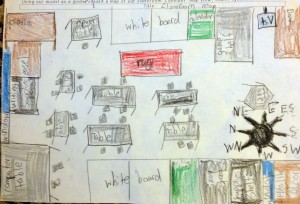 In Social Studies, we are applying our knowledge of scale, orientation, symbols, labels, and view when creating classroom maps. Check out the example above: notice how the places in the classroom are draw to relative scale, with the center of the room in the center of the map (orientation). The view is an appropriate combination of map view and bird’s eye view, and objects/places are symbolic (e.g. just a shape) and labeled. The compass rose is placed correctly to show position and is labeled, too. At home, kids can create similar maps of places important to them, then bring them in to show us!
In Social Studies, we are applying our knowledge of scale, orientation, symbols, labels, and view when creating classroom maps. Check out the example above: notice how the places in the classroom are draw to relative scale, with the center of the room in the center of the map (orientation). The view is an appropriate combination of map view and bird’s eye view, and objects/places are symbolic (e.g. just a shape) and labeled. The compass rose is placed correctly to show position and is labeled, too. At home, kids can create similar maps of places important to them, then bring them in to show us!
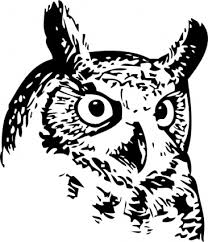 In science, students were given a great opportunity last week to ask questions and conduct an investigation using scientific tools through their exploration of owl pellets! Using bone identification charts to guide them, they learned to follow a procedure while collecting observable data, after which they drew conclusions about the eating habits of owls.
In science, students were given a great opportunity last week to ask questions and conduct an investigation using scientific tools through their exploration of owl pellets! Using bone identification charts to guide them, they learned to follow a procedure while collecting observable data, after which they drew conclusions about the eating habits of owls.
Our life science work wraps up this week by teaching students to research information. Students have chosen a nocturnal animal in order to study its adaptations. They will read with a question in mind; tag relevant information; use organizers to write their ideas; and create a poster with realistic drawings, labels, and descriptions. Smart!
Here’s pictures of us with our Rotary Reader, Brent Arnold; bar modelling in action; and owl pellet dissection.

